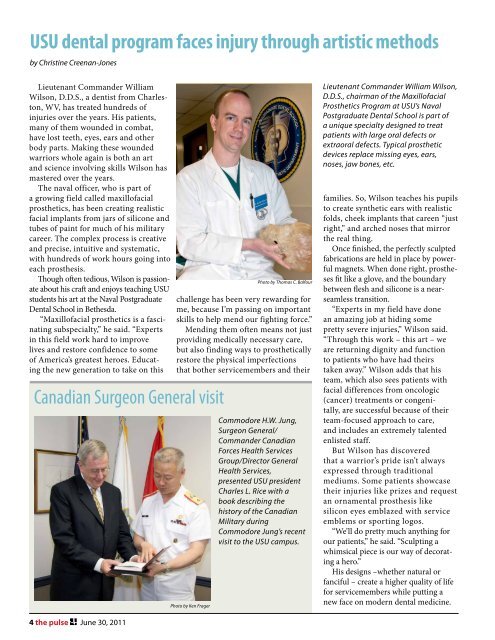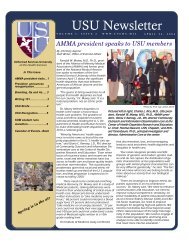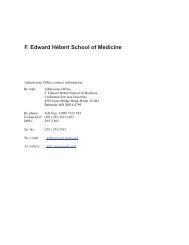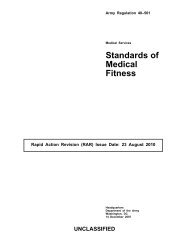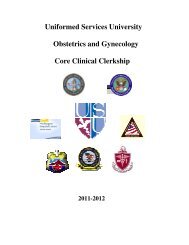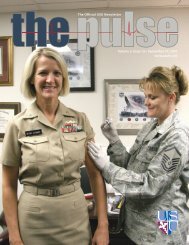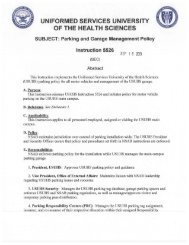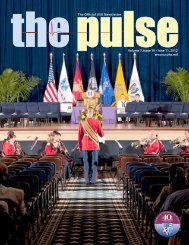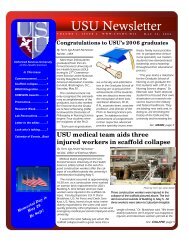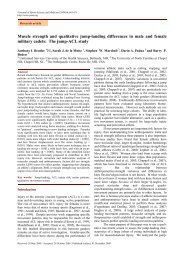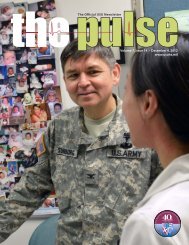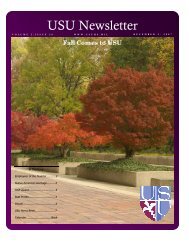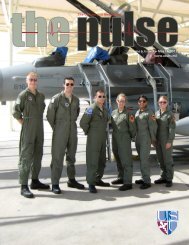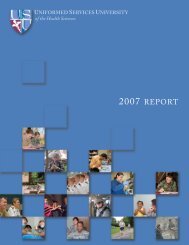Vol. 6, Issue 12 06/30/11 - Uniformed Services University of the ...
Vol. 6, Issue 12 06/30/11 - Uniformed Services University of the ...
Vol. 6, Issue 12 06/30/11 - Uniformed Services University of the ...
You also want an ePaper? Increase the reach of your titles
YUMPU automatically turns print PDFs into web optimized ePapers that Google loves.
USU dental program faces injury through artistic methods<br />
by Christine Creenan-Jones<br />
Lieutenant Commander William<br />
Wilson, D.D.S., a dentist from Charleston,<br />
WV, has treated hundreds <strong>of</strong><br />
injuries over <strong>the</strong> years. His patients,<br />
many <strong>of</strong> <strong>the</strong>m wounded in combat,<br />
have lost teeth, eyes, ears and o<strong>the</strong>r<br />
body parts. Making <strong>the</strong>se wounded<br />
warriors whole again is both an art<br />
and science involving skills Wilson has<br />
mastered over <strong>the</strong> years.<br />
The naval <strong>of</strong>ficer, who is part <strong>of</strong><br />
a growing field called maxill<strong>of</strong>acial<br />
pros<strong>the</strong>tics, has been creating realistic<br />
facial implants from jars <strong>of</strong> silicone and<br />
tubes <strong>of</strong> paint for much <strong>of</strong> his military<br />
career. The complex process is creative<br />
and precise, intuitive and systematic,<br />
with hundreds <strong>of</strong> work hours going into<br />
each pros<strong>the</strong>sis.<br />
Though <strong>of</strong>ten tedious, Wilson is passionate<br />
about his craft and enjoys teaching USU<br />
students his art at <strong>the</strong> Naval Postgraduate<br />
Dental School in Be<strong>the</strong>sda.<br />
“Maxill<strong>of</strong>acial pros<strong>the</strong>tics is a fascinating<br />
subspecialty,” he said. “Experts<br />
in this field work hard to improve<br />
lives and restore confidence to some<br />
<strong>of</strong> America’s greatest heroes. Educating<br />
<strong>the</strong> new generation to take on this<br />
Canadian Surgeon General visit<br />
Photo by Thomas C. Balfour<br />
challenge has been very rewarding for<br />
me, because I’m passing on important<br />
skills to help mend our fighting force.”<br />
Mending <strong>the</strong>m <strong>of</strong>ten means not just<br />
providing medically necessary care,<br />
but also finding ways to pros<strong>the</strong>tically<br />
restore <strong>the</strong> physical imperfections<br />
that bo<strong>the</strong>r servicemembers and <strong>the</strong>ir<br />
Photo by Ken Frager<br />
Commodore H.W. Jung,<br />
Surgeon General/<br />
Commander Canadian<br />
Forces Health <strong>Services</strong><br />
Group/Director General<br />
Health <strong>Services</strong>,<br />
presented USU president<br />
Charles L. Rice with a<br />
book describing <strong>the</strong><br />
history <strong>of</strong> <strong>the</strong> Canadian<br />
Military during<br />
Commodore Jung’s recent<br />
visit to <strong>the</strong> USU campus.<br />
Lieutenant Commander William Wilson,<br />
D.D.S., chairman <strong>of</strong> <strong>the</strong> Maxill<strong>of</strong>acial<br />
Pros<strong>the</strong>tics Program at USU’s Naval<br />
Postgraduate Dental School is part <strong>of</strong><br />
a unique specialty designed to treat<br />
patients with large oral defects or<br />
extraoral defects. Typical pros<strong>the</strong>tic<br />
devices replace missing eyes, ears,<br />
noses, jaw bones, etc.<br />
families. So, Wilson teaches his pupils<br />
to create syn<strong>the</strong>tic ears with realistic<br />
folds, cheek implants that careen “just<br />
right,” and arched noses that mirror<br />
<strong>the</strong> real thing.<br />
Once finished, <strong>the</strong> perfectly sculpted<br />
fabrications are held in place by powerful<br />
magnets. When done right, pros<strong>the</strong>ses<br />
fit like a glove, and <strong>the</strong> boundary<br />
between flesh and silicone is a nearseamless<br />
transition.<br />
“Experts in my field have done<br />
an amazing job at hiding some<br />
pretty severe injuries,” Wilson said.<br />
“Through this work – this art – we<br />
are returning dignity and function<br />
to patients who have had <strong>the</strong>irs<br />
taken away.” Wilson adds that his<br />
team, which also sees patients with<br />
facial differences from oncologic<br />
(cancer) treatments or congenitally,<br />
are successful because <strong>of</strong> <strong>the</strong>ir<br />
team-focused approach to care,<br />
and includes an extremely talented<br />
enlisted staff.<br />
But Wilson has discovered<br />
that a warrior’s pride isn’t always<br />
expressed through traditional<br />
mediums. Some patients showcase<br />
<strong>the</strong>ir injuries like prizes and request<br />
an ornamental pros<strong>the</strong>sis like<br />
silicon eyes emblazed with service<br />
emblems or sporting logos.<br />
“We’ll do pretty much anything for<br />
our patients,” he said. “Sculpting a<br />
whimsical piece is our way <strong>of</strong> decorating<br />
a hero.”<br />
His designs –whe<strong>the</strong>r natural or<br />
fanciful – create a higher quality <strong>of</strong> life<br />
for servicemembers while putting a<br />
new face on modern dental medicine.<br />
4 <strong>the</strong> pulse June <strong>30</strong>, 20<strong>11</strong>


